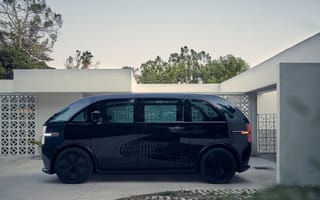
The car of the future is electric, shared, autonomous and doesn’t look much like a car at all — at least, according to Canoo.
On Tuesday, Canoo unveiled its first electric vehicle model, called canoo (yes, the company’s name, but lowercase). LA-based startup Canoo launched in December 2017 with the goal of creating electric vehicles for the cities of the future. Now that it has officially revealed its first car to the world, it’s one step closer to achieving this goal. The company says it’s on track to launch its car to the public in 2021.

It’s hard not to notice the way canoo looks. Other electric vehicles tend to resemble traditional gas-powered cars, but there’s no real reason for this. Electric vehicles don’t need space in the front hood for an engine, and they don’t need a gas tank. So when Canoo designed its electric vehicle, it decided to do something different.
“The design capitalizes on the space that an electric vehicle allows,” James Cox, the head of product at Canoo, told Built in. “It feels like a loft on wheels.”
It feels like a loft on wheels.”
Cox explained that traditional car designs aren’t built to maximize space for the people in them. So Canoo decided to design the interior of its vehicle to feel more like an open room. The car can fit up to seven people inside, but it’s got the footprint of a Volkswagen Golf (442cm long, 190cm wide, 185cm tall).
The interior of the car has side benches, backward-facing seats and skylight windows. The vehicle also has enough space in the backseat to fit a bicycle or surfboard comfortably.

There are also several mechanical aspects that set apart canoo from a traditional car.
One of the most striking is the vehicle’s steer-by-wire steering column. Traditional steering wheels are connected to the wheels of a car mechanically, which means the force of the turning wheel is what physically turns the wheels (with a little hydraulic help). But Cox said Canoo will be the first company to deploy a vehicle with steer-by-wire, which steers the car using electrical signals only. This is supposed to make steering more responsive and will eliminate the need to rotate the steering wheel multiple times when making sharp turns or parking.
The mechanics of canoo are also built into the car’s base, which the company refers to as its “skateboard.” This is where the wheels connect to a rigid platform that houses the car’s battery — which gives the car a range of 250 miles, and can reach 80 percent charge in less than 30 minutes — and electric drivetrain.

The skateboard design also allows Canoo to design and fasten the cabin of the car separately. That means the company can design different car models while keeping the functional essentials the same.
The car also has seven cameras, five radars and 12 ultrasonic sensors, allowing the car to integrate advanced driver-assistance systems and Driver Monitoring. It will also pave the way for canoo to become an autonomous vehicle. The company says that it installed the hardware necessary so it can later partner with a company working on self-driving technologies and put it into its vehicles.

Canoo plans on making its cars available through a direct-to-consumer subscription-only model. To operate a Canoo vehicle, customers will have to pay a monthly fee which includes access to the car, insurance, maintenance and registration. Unlike a standard car lease, there’s no time requirement. So people can sign up as soon as they want a car, keep it for as many months as they’d like, and cancel anytime.
Canoo didn’t reveal how much the monthly subscription will cost. However, Cox did say that offering the car through a subscription would keep the price affordable. Expect details about pricing to be announced closer to 2021.
The subscription-only model is a very different approach to car ownership — kinda like how canoo is a very different approach to a car — but Cox said this type of change is necessary for future cities. And the company is building a team to bring this vision to the world.
Currently Canoo has almost 400 employees, with a headquarters in LA and offices in Silicon Valley and Shanghai. The company is still growing and actively looking for more software developers and engineers to join the team.
Now that the company unveiled its first car, it’s gearing up for its eventual launch in 2021. Part of this includes taking the vehicle on a reveal tour so people can see it in person. On Sunday, Sept. 29 Canoo will showcase the car at the Abbot Kinney Festival. Then the car will make an appearance Oct. 20 at the ArtCenter Car Classic. Both of these events are open to the public.





